



The 6th Hainan Danzhou tournament is being held from the 2nd to 11th of July 2015 in Danzhou. The major attractions of the tournament are the top rated Chinese player and the guy who has worked with Magnus Carlsen Ding Liren; the winner of the Capablanca Memorial and the strongest open tournament ever held, the Qatar Masters Yu Yangyi; and the youngest person in the world to break into 2700 Wei Yi.

When the 6th Danzhou tournament began on 2nd of July 2015, a friend and I decided to predict the winner of the event. Though Ding Liren was the top seed, I decided to put my money on the winner of the recently concluded Capablanca Memorial Yu Yangyi. The Chinese player had had a phenomenal performance of 2862 in that event, and had won it by a huge margin of 1.5 points. The friend went for Wei Yi who at the age of just 16 years has a mind-blowing Elo of 2724. My confidence in Yu Yangyi’s success increased manifold when he won a fine game against Sasikiran in round one, and my friend’s excitement knew no bounds when Wei Yi created his wonderful brilliancy against Batista Bruzon in round two. But as the tournament progressed both these players slowed down and it was the experienced 28-year-old GM Wang Yue who began to score one victory after another to win the 6th Hainan Danzhou GM tournament.

With a 2887 performance and a score of 7.0/9,,
Wang Yue won
the tournament a point ahead of the second place [photo by Fred Lucas]
With this achievement Wang Yue gained 19 Elo points and moved ten spots up the rating chart to number 22 in the world. After winning a fine positional game against Lu Shanglei, Wang Yue drew the next game with Ni Hua with ease. The third round was a huge test for him as he faced Wei Yi, who had just demolished Bruzon in the previous round. Wang Yue used all his experience to select a very quiet Anti-Grunfeld system against the youngster. This turned out to be a superb decision as he slowly but surely outplayed his opponent in a double rook endgame. A solid draw followed against Bu Xiangzhi in round four. In the fifth round he had the white pieces against the King’s Indian expert and top seed of the tournament Ding Liren. This time Wang Yue didn’t shy away from a battle and after a complex middlegame, he steered the fight into his strong point, which is the endgame. Although we have already shown you that game in our previous report, the brilliance of the idea employed by Wang Yue surely requires an encore!

Wang Yue won with 55.Bd1! Kh6 56.b4!! cxb4 57.Bb3!, trapping the bishop on a5 and taking his king over to the kingside and queening one of his pawns.
In the sixth round, employing the quiet Petroff Variation against Bruzon, he managed to outplay his Cuban opponent and had already taken a healthy lead with a score of +4. This could well have been enough for the title, but not being content he scored his fourth win on a trot with the white pieces in the seventh round against Wang Chen. This was followed by draws in eighth and ninth rounds against Yu Yangyi and Sasikiran. 7.0/9! A remarkable performance!
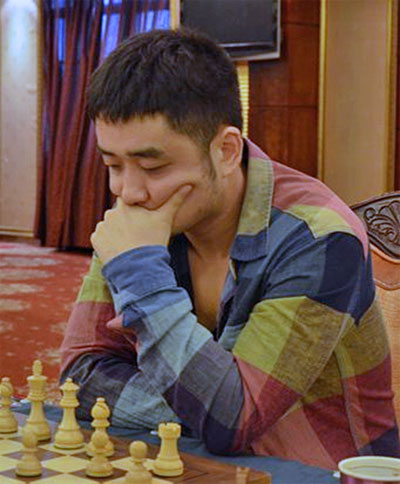
Wang Yue went back home richer by 100,000 Yuans (US $16,100)
Wang Yue had a career high rating of 2756 back in November, 2010. Since then his rating has been around the 2700-2720 mark. With this victory we might well see a resurgent Wang Yue who will aim to once again break into the top ten players of the world. In 2010, our news page reported on Wang Yue’s victory as the World University Champion and you can read an enlightening interview taken in that article by Philipp Kaufmann and Richard Forster over here.

Though Wang Yue is known as a positional and endgame expert, his game against Wang Chen in the seventh round was a nice tactical battle worthy of closer inspection.

[Event "6th Hainan Danzhou GM"] [Site "Danzhou CHN"] [Date "2015.07.09"] [Round "7.1"] [White "Wang, Yue"] [Black "Wang, Chen"] [Result "1-0"] [ECO "A07"] [WhiteElo "2716"] [BlackElo "2521"] [Annotator "Sagar Shah"] [PlyCount "113"] [EventDate "2015.07.02"] 1. Nf3 d5 2. g3 e6 3. Bg2 g6 4. O-O Bg7 5. d4 Ne7 {Wang Chen is one of those few players in the world who regularly likes to develop his knight to e7 and his bishop to g7.} 6. Nbd2 O-O 7. e4 b6 8. Re1 Bb7 9. e5 c5 10. c3 {We have transposed into some sort of King's Indian Attack setup.} a5 11. Nf1 Nbc6 12. Ne3 h6 13. h4 cxd4 14. cxd4 Ba6 15. a3 {Preventing Nb4.} Rc8 16. b3 Kh7 17. Bh3 Rc7 18. Ng4 Ng8 {Trying to take care of the dark squares on f6 and h6, but the knight is just too passive.} (18... Nf5 {was definitely a better square for knight.}) 19. Bf4 Rc8 20. Qd2 a4 21. bxa4 (21. b4 {looked much more natural.}) 21... Na5 22. Reb1 Nc4 23. Qd1 Qe7 24. Ne3 Qa7 25. Ng4 $6 (25. h5 {immediately starting the attack would have been much stronger.}) 25... Bb7 26. Bf1 $1 { Bringing the bishop to the d3 square in order to launch a direct attack against the black king.} Bc6 27. Rb4 $1 Rfd8 28. Bd3 Bf8 29. h5 $1 {Wang Yue is in his element. Of course we all know him as the positional expert or the endgame wizard but here he shows his dynamic feel for the game.} Bxb4 30. axb4 {White is more than happy to give up his b4 rook for the prized kingside defender. Now there are four minor pieces attacking the black king and only one defending him.} Nb2 31. hxg6+ fxg6 32. Bxg6+ $1 Kxg6 33. Qb1+ Kg7 34. Qxb2 {White has two pawns for an exchange and the king cover is ripped into pieces. The rest is just pain for Wang Chen.} Qf7 35. Qd2 (35. Nf6 {would have been much stronger as after} Nxf6 36. exf6+ Kg8 37. Ne5 Qxf6 38. Qd2 Kh7 (38... Kg7 $2 39. Nxc6 Rxc6 40. Be5 $18) 39. Kg2 $1 $18 {[%cal Ga1h1] The rook comes to h-file and decides the game.}) 35... Qh5 36. Nfh2 Be8 37. Ne3 Qh3 38. a5 {Sort of opening a second front.} bxa5 39. bxa5 Ne7 40. a6 Ra8 41. Ng2 (41. Neg4 Ng8 42. Nf6 Nxf6 43. exf6+ Kh7 44. Rb1 $18 {leads to a winning attack.}) 41... Qh5 42. g4 Qg6 43. Bg3 Rdb8 44. Nf4 Rb1+ 45. Kg2 Rxa1 46. Nxg6 Bxg6 47. Bh4 Ra7 48. Bf6+ Kh7 49. Qb4 Ng8 50. Nf3 R1xa6 (50... Be4 {eliminating the knight might have been a better idea.}) 51. Nh4 Bd3 52. Kg3 Rc6 53. Ng2 {The knight makes his way to the f4 square and the bishop is sort of trapped.} Bc2 (53... Rc4 54. Qb8 $18) 54. Nf4 Rf7 55. f3 Rfc7 56. Qf8 Ra6 57. Qe8 {A fine attacking display by Wang Yue.} 1-0
This is a Playchess lecture from last night
analysing Wang Yue's wins.
it is 1h 40min long – definitely something for a reclining chair and
a nice glass of wine.
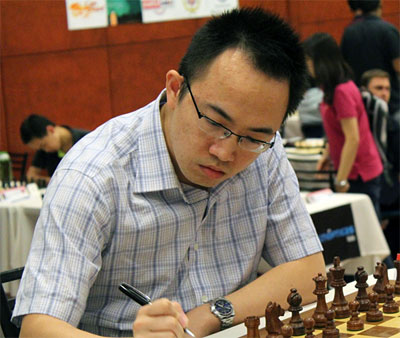
The only other player in the tournament apart
from Wang Yue who performed above his Elo was Ni Hua,
who with three wins and 6.0/9 finished second, gaining eleven Elo points
[picture by Amruta Mokal]
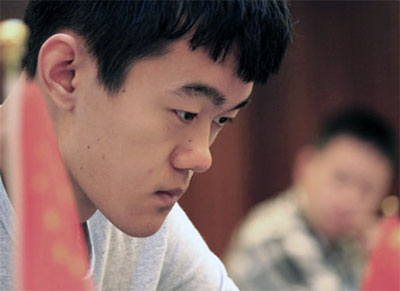
The Chinese number one, Ding Liren, lost a crucial encounter against the winner Wang Yue, but then covered the lost ground and finished third with 5.5/9. His victory against Lu Shanglei is must see for any player who would like to acquaint himself with the tactics that arise in an IQP structure.

[Event "6th Hainan Danzhou GM"] [Site "Danzhou CHN"] [Date "2015.07.10"] [Round "8.3"] [White "Ding, Liren"] [Black "Lu, Shanglei"] [Result "1-0"] [ECO "D50"] [WhiteElo "2749"] [BlackElo "2595"] [Annotator "Sagar Shah"] [PlyCount "39"] [EventDate "2015.07.02"] 1. d4 d5 2. c4 e6 3. Nc3 Nf6 4. Bg5 dxc4 5. e3 a6 6. a4 h6 7. Bh4 b6 8. Bxc4 Bb7 9. Nf3 c5 10. O-O cxd4 11. exd4 Be7 12. Qe2 O-O 13. Rad1 Nc6 14. Rfe1 { White has a perfect position for the d5 break in this Isolated Queen Pawn structure. Lu Shanglei needs to be very careful. A well timed d4-d5 push usually spells doom for the black player very quickly.} Nd5 $6 (14... Re8 { looks natural but is met with a strong sacrifice} 15. Bxe6 $1 (15. Ne5 $5 {is also very strong.}) 15... fxe6 16. Qxe6+ Kh8 17. d5 Bf8 (17... Nb4 18. Ne5 $16) 18. dxc6 $1 Rxe6 19. Rxe6 $1 Qb8 20. cxb7 Qxb7 21. Ne5 $36 {With a powerful initiative for White.}) (14... Na5 15. Ba2 {does not really help.}) ({ According to the engines, the only way for Black to stay in the game is by making a very unusual move} 14... Qe8 $1 15. d5 (15. Bxe6 fxe6 16. Qxe6+ Qf7 17. d5 Qxe6 18. Rxe6 Nxd5 19. Nxd5 Bc5 $44) 15... exd5 16. Bxf6 (16. Nxd5 Nxd5 17. Bxd5 Bxh4 $11) 16... Bxf6 17. Qf1 $1 Ne7 (17... dxc4 18. Rxe8 Rfxe8 19. Qxc4 Na5 $14 {Black might have some chances of holding here.}) 18. Nxd5 Bxd5 19. Bxd5 Ra7 $14 {And even though in a very clumsy manner, Black still holds on.}) (14... Nb4 $2 {Controlling the d5 square further doesn't help. White already has more control than Black.} 15. d5 $1 Nbxd5 16. Nxd5 Nxd5 17. Bxd5 Bxd5 18. Bxe7 Qxe7 19. Rxd5 $18) 15. Bxd5 $1 Bxh4 (15... exd5 $2 16. Bxe7 $18) 16. Be4 $1 {The d5 break is still on cards.} Re8 $2 (16... Bf6 {was relatively the best but White retains an advantage after} 17. d5 exd5 18. Nxd5 $16) 17. d5 $1 exd5 18. Rxd5 Qe7 19. Qd2 {Threatening Rd7.} Qf6 20. Rd7 {A nice miniature win for Ding Liren.} (20. Rd7 Rab8 21. Nd5 $1 {and just like that the queen is trapped in the center of the board.} Qe6 22. Bh7+ Kxh7 23. Rxe6 Rxe6 24. Nxh4 $18) 1-0
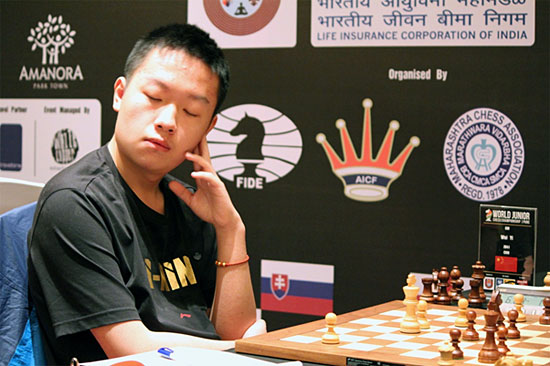
Fourth place finish for Wei Yi who scored 5.0/9 [picture by Amruta Mokal]
Wei Yi might not be exactly happy with his performance in this tournament. But I would say that the youngster played two sublime games. One was, of course, his much acclaimed game against Batista Bruzon. Here he played with great energy and an excellent combinative vision. But equally impressive was his last round bout against Bu Xiangzhi. This game escaped the eyes of the chess fans for two reasons: one because it was a technical game where Wei Yi tried to milk a miniscule advantage; and two because he botched up a completely winning position and the game ended in a draw. Yet I would ask the readers to look over the game with great attention, as it shows how versatile this young lad is.

[Event "6th Hainan Danzhou GM"] [Site "Danzhou CHN"] [Date "2015.07.11"] [Round "9.5"] [White "Wei, Yi"] [Black "Bu, Xiangzhi"] [Result "1/2-1/2"] [ECO "C42"] [WhiteElo "2724"] [BlackElo "2695"] [Annotator "Sagar Shah"] [PlyCount "204"] [EventDate "2015.07.02"] {After his win against Lazaro Bruzon in round two, everyone felt that Wei Yi would do exceptionally well in the tournament. He did not live up to the expectations, scoring just +1 in the event. However, his last round battle against Bu Xiangzhi is worthy of close inspection not only because Wei Yi was completely winning but this game shows the other side of the 16-year-old Chinese grandmaster.} 1. e4 e5 2. Nf3 Nf6 3. Nxe5 d6 4. Nf3 Nxe4 5. Nc3 Nxc3 6. dxc3 Be7 7. Be3 Nc6 8. Qd2 Be6 9. O-O-O Qd7 10. Kb1 Bf6 11. h3 h5 $5 {Stopping White's expansion with g4.} 12. Nd4 Bxd4 $5 (12... Nxd4 {looks more natural but after} 13. Bxd4 {the bishop on f6 feels uncomfortable because it cannot really move off the diagonal.} Bxd4 14. Qxd4 $14 {The centrally posted queen is very powerful and gives White a small edge.}) 13. Bxd4 (13. cxd4 d5 14. Bf4 $14 {was another valid option.}) 13... f6 {Black would not like to take on d4 and centralize the white queen, but in that process he will leave White with a bishop pair.} 14. Be2 O-O-O 15. Rhe1 Rde8 16. Be3 $14 {White is slightly better as he has the bishop pair. His plan includes, retaining the bishops and slowly but surely advancing his queenside pawns. Look how Wei Yi achieves this. } Bf7 17. b3 Re7 18. f3 Rhe8 (18... h4 19. Bf2 g5 {is possible, but a later f4 break would be pretty strong.}) 19. Bf2 a6 20. h4 Re5 (20... Ne5 {is a good square for the knight as it cannot be kicked off with f4 – it will simply jump into g4. But White will just improve with Kb2, a4 etc. and Black will not be able to do much.}) 21. Bf1 Rd5 (21... Rxe1 22. Rxe1 Rxe1+ 23. Qxe1 Qf5 { could have been a better way to play. In the game, White is able to retain one of his rooks and that puts additional pressure on Black.}) 22. Qf4 (22. Rxe8+ Qxe8 23. Bd4 $1 {is a strong move because the rook on d5 is completely misplaced.} Nxd4 24. cxd4 c5 25. c3 cxd4 26. cxd4 $16 {[%csl Rd5]}) 22... Rxe1 23. Rxe1 Re5 24. Rd1 Bg6 25. Kb2 $1 {improving the position of the king.} Re7 26. Qd2 Re8 27. Be1 Re7 28. Qf2 Qe6 29. Bd2 Qe5 30. Re1 Qa5 31. Be3 Qe5 32. a4 $1 {The queenside pawn offensive begins.} Kd7 33. Qd2 Kc8 34. Bf2 Qf5 35. Rd1 Qd7 36. Be1 Qe6 37. Bf2 Qd7 38. Ra1 $1 {An excellent move: White now plans to activate his rook along the fourth rank with a5 and Ra4. Though objectively it might not be the best idea yet it makes some progress in the position and forces Black to take some concrete measures.} Qe6 39. Bc4 Qd7 40. Bf1 {You can see how Wei Yi patiently repeats the position many times in the game. This is always a good idea when you are pressing in the position as it sometimes frustrates your opponent and makes him take some hasty decision.} Qe6 41. a5 Qe5 42. Bc4 Qf5 (42... Nxa5 $2 43. Re1 Nxc4+ 44. bxc4 $18) 43. Ra4 Qd7 (43... Nxa5 44. Bd3 $16) 44. Bf1 Qe6 45. c4 Qe5+ 46. Qc3 Qxc3+ 47. Kxc3 {The queens are exchanged and in a way it becomes easier to push the queenside pawns now.} Re5 48. b4 Ne7 49. Ra1 {[%csl Ga1,Ga5,Gb4,Gc3,Gc4,Gf1,Gf2] The well placed bishops and rook along with the king and the queenside pawn storm give White excellent chances.} Nf5 50. Bd3 Ne7 51. Bf1 {Once again you see the repetition in action.} Nf5 52. Kd2 Be8 53. Bd3 Bd7 54. b5 g5 {Finally Black decides something must be done but it is already quite late.} (54... axb5 55. f4 Re7 56. cxb5 $16) 55. g3 {A patient move.} ({Wei Yi didn't want to spice up the matters with} 55. bxa6 bxa6 56. c5 $5 $16) 55... axb5 56. f4 gxf4 57. gxf4 Re7 58. cxb5 Nh6 59. a6 {With patience and level headed play Wei Yi has been able to crown his strategy by creating an outside passer. He now has a completely winning position.} bxa6 60. bxa6 Kb8 61. Bd4 Ng4 62. Be2 Bc6 {preventing Bf3.} 63. Ra5 Rh7 64. Bd3 Rh6 65. c4 Rh8 66. Bg6 {The positional advantages will now be converted into a material plus.} Rg8 67. Bxh5 (67. Rxh5 {was maybe even better as the bishop was taboo thanks to back rank mate.}) 67... Be4 68. c5 Nh2 69. cxd6 cxd6 70. Bxf6 {White is two pawns up and it should all be over within a few moves.} Nf1+ 71. Kc3 Rg3+ 72. Kb4 Ne3 73. Rb5+ (73. Rg5 $1 Nd5+ 74. Kc4 Nxf6 75. Rxg3 Nxh5 76. Rg5 Nxf4 77. Rg4 d5+ 78. Kc5 $18 {followed by Kb6 and it's all over.}) 73... Kc7 74. Rg5 Nc2+ 75. Kc4 Ra3 76. Rg7+ Kb6 77. Bd4+ Ka5 ( 77... Kxa6 78. Ra7#) 78. Be8 $2 {A bad mistake by Wei Yi which throws away almost all the advantage.} (78. a7 $1 Ra4+ 79. Kc3 Rxd4 (79... Nxd4 80. a8=Q+ Bxa8 81. Ra7+ Kb5 82. Rxa4 Kxa4 83. Kxd4 $18) 80. Bg6 $1 $18 {A difficult move to see from far. The bishop on e4 is over loaded and White wins the game.}) 78... Rf3 79. Rg5+ Kxa6 80. Bb5+ Kb7 81. Rg7+ Kb8 82. Rg8+ Kb7 83. Rg7+ Kb8 84. Ba7+ Ka8 85. Ba4 Rxf4 86. Kb5 Bb7 $2 (86... Rxh4 87. Kb6 Rh8 $14) 87. Kb6 (87. Bg1 $3 {The only available square for the bishop but good enough to win.} Na3+ 88. Kb6 Rb4+ 89. Ka5 Rxh4 90. Rg8+ $18) 87... Rb4+ 88. Bb5 Rxb5+ $1 89. Kxb5 Kxa7 {Black has overcome the worst and now defends the position without any difficulties.} 90. h5 Nd4+ 91. Kc4 Nf5 92. Rf7 Nh6 93. Rf6 Ng8 94. Rf8 Nh6 95. Kd4 Kb6 96. Ke3 Bd5 97. Kf4 Nf7 98. Rg8 Kc6 99. Rg6 Kd7 100. h6 Nxh6 101. Rxh6 Kc6 102. Rxd6+ Kxd6 {A sad end to the game for Wei Yi, but an experienced chess player will surely be in awe of his technique as well as patience. It was a great technical effort to milk that small advantage against a strong player like Bu Xiangzhi.} 1/2-1/2
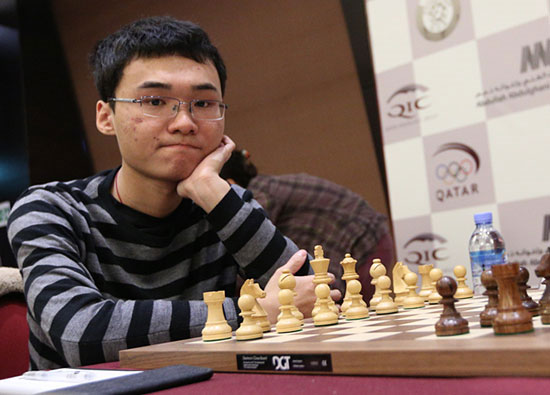
Yu Yangyi who has been having an excellent
year failed to impress at this event
and ended with 4.5/9 [picture by Dmitry Rukhletsky]
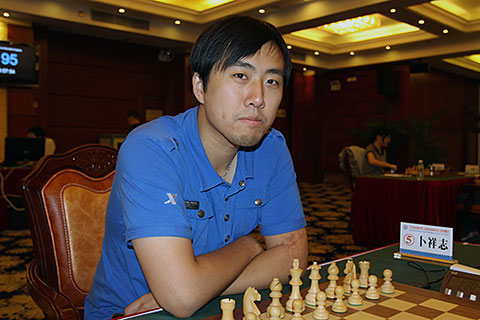
Sixth: Super solid Bu Xinagzhi drew all his games! [Picture by Gu Xiaobing]

Recently Krishnan Sasikiran has not been doing too well. His rating has slumped from 2682 in March 2015 to 2640. In Danzhou, however, he was able to maintain his rating and played some interesting games. One of them was his win against Lázaro Bruzón with the black pieces.

[Event "6th Hainan Danzhou GM"] [Site "Danzhou CHN"] [Date "2015.07.10"] [Round "8.4"] [White "Bruzon Batista, Lazaro"] [Black "Sasikiran, Krishnan"] [Result "0-1"] [ECO "E97"] [WhiteElo "2669"] [BlackElo "2640"] [Annotator "Sagar Shah"] [PlyCount "76"] [EventDate "2015.07.02"] 1. Nf3 Nf6 2. c4 g6 3. Nc3 Bg7 4. e4 d6 5. d4 O-O 6. Be2 e5 7. O-O Nc6 8. d5 Ne7 9. a4 a5 10. Ne1 Nd7 11. Nd3 f5 12. f3 Kh8 13. Bd2 c6 14. Kh1 Nf6 15. dxc6 bxc6 16. c5 {This is the most logical move for White, trying to open up the position for his better developed pieces.} d5 $1 17. Nxe5 d4 ({Also possible was} 17... fxe4 18. fxe4 Nxe4 $1 19. Nf7+ (19. Nxe4 Bxe5 $15) 19... Rxf7 $1 20. Rxf7 Nxd2 $1 21. Qxd2 Nf5 {[%csl Gf5,Gg7] and with strong minor pieces, Black has excellent compensation. White will do well to give up his rook for the g7 bishop and reach an equal position.} 22. Rxg7 Kxg7 $11) 18. Qb3 $5 {This is a crazily complicated position, but let's try to make sense of it. The knight threatens a fork on f7, but why can't we just take the c3 knight? Because after dxc3, White just recaptures Bxc3 and gets great compensation.} (18. Bc4 $5 dxc3 19. Bxc3 $1 Qxd1 20. Rfxd1 {Inspite of being a piece down, White has enough activity to hold the balance.} fxe4 21. Nf7+ Kg8 (21... Rxf7 22. Rd8+ Nfg8 23. Bxf7 $13) 22. Nh6+ Kh8 23. Nf7+ $11) 18... Nxe4 $5 {This is really a good move by Sasikiran but he had a completely non conventional move at his disposal.} (18... dxc3 19. Bxc3 $44 {With Nf7+ coming up, White has excellent compensation.}) (18... Nfg8 $1 {This undeveloping move is the strongest in the position.} 19. Nf7+ $6 {The most obvious move turns out to be a mistake.} Rxf7 20. Qxf7 dxc3 21. Bxc3 $2 (21. Bf4 cxb2 22. Rad1 Bd7 $15) 21... Bxc3 22. bxc3 ( 22. Rad1 Nd5 23. exd5 Nh6 24. dxc6 Nxf7 25. Rxd8+ Nxd8 26. bxc3 Nxc6 $17) 22... Nd5 $3 {and this is the point of the undeveloping move with Nfg8.} 23. exd5 Nh6 $19 {[%csl Rf7] and look how the White queen is trapped on f7.}) 19. Nxe4 (19. Nf7+ Rxf7 20. Nxe4 fxe4 21. Qxf7 e3 $44) 19... fxe4 20. fxe4 $2 (20. Nf7+ Rxf7 21. Qxf7 e3 {Black has excellent compensation but White is still in the game.}) 20... Bxe5 21. Rxf8+ Qxf8 22. Rf1 Qe8 {White is just a piece down without any compensation.} 23. Bh6 Rb8 $1 {A deep move. The rook on b8 will be defended by the e5 bishop and this small detail will change the assessment in Black's favour.} (23... Bg7 24. Bxg7+ Kxg7 25. Qc4 $44 {followed by Qxd4 gives White good compensation.}) (23... Ng8 24. Rf8 Be6 25. Rxe8 Rxe8 (25... Bxb3 26. Rxa8 $18) 26. Qb7 $16) 24. Qd1 (24. Qc4 Ng8 25. Rf8 Be6 26. Rxe8 Bxc4 $19 {And now you can see how the rook is defended by the e5 bishop.}) 24... Ng8 25. Rf8 Qe7 26. Bc4 Be6 27. Rxb8 Qh4 (27... Bxc4 $19) 28. Qg1 Bxc4 29. Re8 Qxe4 30. Bg5 Kg7 {Black has two pieces for the rook and two strong bishops. The rest is easy for Sasikiran.} 31. Bd2 Bf7 32. Rd8 Nf6 33. Bxa5 Bd5 34. Bd2 Qe2 35. Bg5 Ne4 36. Rd7+ Kg8 37. Rd8+ Kf7 38. Rd7+ Ke6 {A game with high quality tactical possibilities.} 0-1
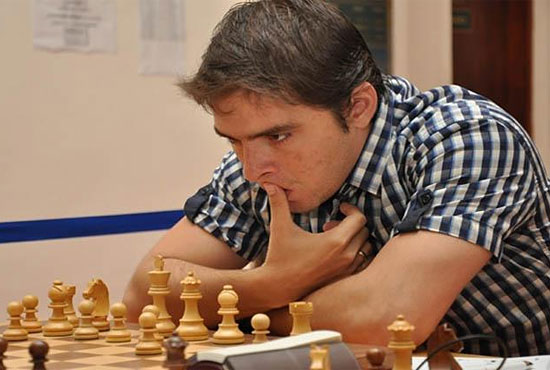
The Cuban number two didn’t have a great event. Apart from finishing seventh, he also lost nine Elo points. The only silver lining for him was his win against the current World Junior Champion Lu Shanglei. The interesting part about the game is that until move number 22 it was all equal. But a blunder from Lu Shanglei and the game ended on the 23rd move! Why the Chinese player threw in the towel was also not at all obvious as no real threats were visible. But when you look deeper you find that the resignation was completely justified.

[Event "6th Hainan Danzhou GM"] [Site "Danzhou CHN"] [Date "2015.07.11"] [Round "9.3"] [White "Lu, Shanglei"] [Black "Bruzon Batista, Lazaro"] [Result "0-1"] [ECO "A00"] [WhiteElo "2595"] [BlackElo "2669"] [Annotator "Sagar Shah"] [PlyCount "46"] [EventDate "2015.07.02"] 1. Nc3 e5 2. Nf3 Nc6 3. d4 exd4 4. Nxd4 Nf6 5. g3 Bb4 6. Bg2 O-O 7. O-O Bxc3 8. bxc3 Re8 9. Rb1 h6 10. Re1 Ne4 11. Nxc6 bxc6 12. Qd4 c5 13. Qd3 d5 14. Ba3 Qf6 15. Bxe4 dxe4 16. Qe3 Qa6 17. Bxc5 Qxa2 18. Ra1 Qxc2 19. Rec1 Qb3 20. Rcb1 Qc4 21. Rxa7 Rxa7 22. Bxa7 Bg4 {The position is round about equal, but with this move Lu Shanglei goes horribly wrong.} 23. Rb4 $4 Qa2 $1 {And Lu Shanglei resigned the game. A premature resignation? I don't think so.} (23... Qa2 $1 { This position is a perfect manifestation of opposite coloured bishop middlegame. The side that has the initiative or is attacking is like a piece up. Here Black's attack on the light squares cannot really be halted.} 24. Kg2 {preventing Bh3.} (24. f3 Qa1+ 25. Kf2 (25. Kg2 exf3+ $19) 25... Bh3 26. Qd4 e3+ $1 27. Qxe3 Qf1#) (24. Kf1 f5 $1 25. Bd4 Qa1+ 26. Kg2 g5 {The threat of Bh3+ followed Qf1# cannot be averted.}) 24... Bxe2 $1 {Now Bf3+ is a huge threat.} 25. Rxe4 Bf1+ $1 (25... Qd5 {is equally good.} 26. f3 (26. Qxe2 Qxe4+ $19) 26... Bxf3+ 27. Kxf3 f5 $19) 26. Kxf1 (26. Kg1 Rxe4 27. Qxe4 Bh3 $1 28. Qe1 Qxa7 $19) 26... Qb1+ 27. Kg2 Qxe4+ $19) (23... Qxe2 24. Qxe2 Bxe2 25. Rb2 { is definitely slightly better for Black but would have been quite difficult to convert.} Bc4 $15) 0-1
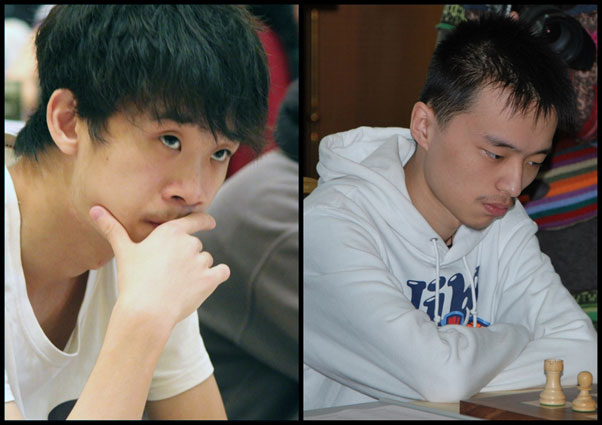
The two lower seeds, Lu Shanglei and Wang Chen
had a forgettable event
with both them scoring 2.5/9 (five draws and four losses)
LinksThe games are being broadcast live on the official web site and on the chess server Playchess.com. If you are not a member you can download a free Playchess client and get immediate access. You can also use ChessBase 12 or any of our Fritz compatible chess programs. |